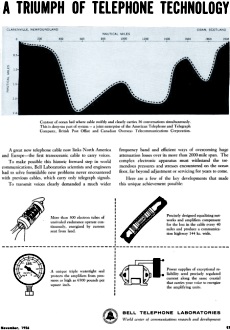|
Prior to satellite communications,
long-distance messages were carried by footmen, horses and riders, smoke signals,
trains, airplanes, boats, lanterns, sign language, printed media, radio frequency,
and cables. All had their advantages and disadvantages, but none other than cable
could provide reliable, nearly instantaneous conversations across and between continents
- or cities for that matter. Stringing wires on poles over the landscape was a relatively
simple task compared to that of laying cable along the ocean floor. Maintenance
on underwater cable and amplifiers was exceedingly difficult or even impossible
in some sections. Developing a suitable insulation to withstand the harsh salt water
environment and the extreme pressures at great depths (which
tends to force water through insulation) was no trivial task. Deployment
came with its own perils for ship, crew, and cable. Breakage during the laying process
was common. It was a major victory when AT&T, the British PO and the Canadian
OTC managed a 2000-mile transoceanic telephone cable capable of carrying a whopping
36 concurrent conversations, as reported in this 1956 issue of Radio &
Television News magazine.
Bell Telephone Laboratories Ad - Transatlantic Cable
 Contour of ocean bed where cable swiftly
and clearly carries 36 conversations simultaneously. This is deep-sea part of system
- a joint enterprise of the American Telephone and Telegraph Company, British Post
Office and Canadian Overseas Telecommunications Corporation. Contour of ocean bed where cable swiftly
and clearly carries 36 conversations simultaneously. This is deep-sea part of system
- a joint enterprise of the American Telephone and Telegraph Company, British Post
Office and Canadian Overseas Telecommunications Corporation.
A great new telephone cable now links North America and Europe - the first transoceanic
cable to carry voices.
To make possible this historic forward step in world communications, Bell Laboratories
scientists and engineers had to solve formidable new problems never encountered
with previous cables, which carry only telegraph signals.
To transmit voices clearly demanded a much wider frequency band and efficient
ways of overcoming huge attenuation losses over its more than 2000-mile span. The
complex electronic apparatus must withstand the tremendous pressures and stresses
encountered on the ocean floor, far beyond adjustment or servicing for years to
come.
Here are a few of the key developments that made this unique achievement possible:
More than 300 electron tubes of unrivaled endurance operate continuously, energized
by current sent from land.
A unique triple watertight seal protects the amplifiers from pressures as high
as 6500 pounds per square inch.
Precisely designed equalizing networks and amplifiers compensate for the loss
in the cable every 40 miles and produce a communication highway 144 kc. wide.
Power supplies of exceptional reliability send precisely regulated current along
the same coaxial that carries your voice to energize the amplifying units.
Bell Telephone Laboratories
World center of communications research and development
Posted July 27, 2022
(updated from original post on
(4/13/2015)
| Bell Telephone
Laboratories Infomercials |
-
Bell Telephone Laboratories - Time Domain Reflectometry - December 1948 Popular
Science
-
The Future Holds Great Promise - August 1949 Popular Science
-
Waveguide: 7/47 Popular Mechanics
-
Wire Wrapping - 10/1953 Popular Science
-
X-Rays, 4/60 Radio-electronics
- The Battle of
the Atoms, 4/1948 Radio News
-
The Transistor, 6/1952 Radio-Electronics
- 90-Mile Laboratory
for Telephone and Television, 6/1945 Radio News
-
Wire-Wrap, 10/53 Radio-Electronics
-
EDT Crystals, 10/47 Radio-Craft
- Germanium Refining,
5/54 Radio & TV News
- Crystal Timekeeping,
1/46 Radio News
- Transatlantic
Cable, 11/56 Radio & Television News
- Pipe Circuits,
11/48 Radio & Television News
-
Coaxial
Electron Tube, 6/54 Radio & Television News
- Thermocompression
Wire Bonding, 3/58 Radio News
-
Radio Relay Stations, 8/52 Radio & Television News
- Isolators,
6/56 Radio & Television News
- Punch
Cards, 3/55 Radio & Television News
-
Over-the-Horizon
Communications, 10/55 Radio & Television News
- Memory
Devices, 2/58 Radio & TV News
-
Adventure in Silicon, 5/55 Radio & Television News
- Pipes of Progress,
6/55 Radio & Television News
-
Project Echo, 11/60 Electronics World
|
-
Testing Phones - November 1947 Popular Science
-
Jacques Bernoulli, February 1960 Radio-Electronics
-
Type-O Carrier System, October 1952 Radio-Electronics
-
Electron Microscope, 4/1952 Radio-Electronics
-
Thermistor, 11/1946 Radio-Craft
-
Germanium Crystal, 1/1954 Radio-Electronics
-
Lens
Antenna, 5/46 Radio-Craft
- Quality Control, 6/46
Radio News Article
- Transcontinental
Radio-Relay, 10/51 Radio & TV News
- Solar
Battery, 7/54 Radio & Television News
-
Germanium Transistors, 1/54 Radio & Television News
- Cavity
Magnetron, 10/45 Radio News
-
The Cableman, 10/49 Radio & Television News
-
Coaxial Cable, 12/49 Radio & Television News
-
Tin
Whiskers, 12/55 Radio & Television News
- Relay
Contact Inspection, 7/55 Radio & Television News
- Transistor's
10th Anniversary, 6/58 Radio & Television News
-
Wire
Wrapping, 10/53 Radio & Television News
- Junction
Diode Amplifier, 11/58 Radio News
-
Nobel Prize Winners, 2/57 Radio & Television News
-
Diode Speeds Voices, 8/58 Popular Electronics
-
Microwave Relays, 7/59 Electronics World
|
|









